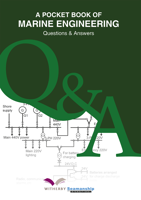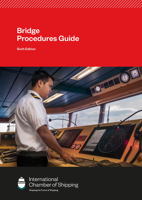Published: February 2024
The guide sets out routine engine room procedures and includes useful checklists for the ship?s engineering team. It provides clear guidance on safe and environmentally responsible engine room operation and maintenance, supporting internationally agreed standards and recommendations adopted by the International Maritime Organization (IMO).
The guide is an invaluable tool for Chief Engineers and other members of the engineering team, as well as shipping companies and training institutions.
It is recommended that a copy is carried on board every merchant ship.
Key features in the second edition:
- Updated Content: The new edition embraces internationally agreed regulations of the IMO, ensuring that engine room crew have access to current and reliable procedures that support greenhouse gas emissions measures, such as how to safely conduct low load operations.
- Expanded Coverage: The guide covers a wide array of engine room procedures, from routine maintenance to emergency response protocols, providing a comprehensive reference for crew members. The guide includes crucial new procedures on handling alternative fuels such as liquefied natural gas, and highlights the latest common engine room deficiencies to help crew prepare for port state control inspections.
- Enhanced Safety Measures: Safety is a top priority in the maritime industry, and this edition emphasises safety procedures to ensure the well-being of all crew members and the environment. It includes updated and consolidated enclosed space entry procedures that align with latest industry best practice.
- User-Friendly Design: The guide is designed for ease of use, with a clear layout and navigational features that make finding the right information quick and straightforward.
Content:
Abbreviations
Definitions
Chapter 1
Introduction
1.1 The value of procedures
1.2 Changes in the engine room
1.3 An effective engineering team
1.4 Documentation
1.5 Environmental protection
1.6 Company policy and procedures
1.6.1 The Safety Management System (SMS)
1.6.2 Drug and alcohol policy
1.6.3 Personal electronic devices and cyber security
1.6.4 Smoking policy
Chapter 2
Engineering department organisation
2.1 Chief engineer
2.1.1 Role as director of operations
2.1.2 Standing orders
2.1.3 Night and day orders
2.2 The engineering team
2.2.1 The watchkeeping team, for ships that operate a watchkeeping system
2.2.2 The UMS team, for ships operating a UMS system
2.2.3 The maintenance team
2.3 Familiarisation of new crew
2.4 Role of the electro-technical officer (ETO)
Chapter 3
Engineering team management
3.1 Officer in charge of an engineering watch (EOOW)
3.1.1 Chief engineer's representative
3.1.2 Primary duties
3.1.3 Secondary duties
3.2 Watchkeeping ratings
3.3 The maintenance team
3.3.1 The planned maintenance system (PMS)
3.3.2 Senior maintenance engineer
3.3.3 Ratings
3.4 The human element
3.4.1 'Just culture'
3.4.2 Challenging decisions
3.4.3 Thinking aloud
3.4.4 Personal protective equipment (PPE)
3.5 Work and rest hours
Chapter 4
Communication
4.1 A common working language
4.2 Quality of communication
4.2.1 Closed loop system
4.2.2 Recording devices
4.2.3 Communication and people's cultures
4.3 Briefing and debriefing
4.4 Communication with the bridge
4.4.1 Situation reviews
4.4.2 Unattended machinery space (UMS) operation
4.4.3 Manoeuvring
4.5 Communication with other departments
4.5.1 Cargo operations
4.5.2 Hotel and other departments
4.6 Call for help
4.6.1 Night call outs
4.6.2 Engineers' call alarm
4.7 Radio communication
4.8 Talkback and sound-powered phones
Chapter 5
Safety of the ship
5.1 General
5.2 Regulations
5.3 Fire
5.3.1 Causes
5.3.2 Prevention
5.3.3 Preparedness and response
5.4 Flooding
5.4.1 Causes
5.4.2 Prevention, preparedness and response
5.4.3 Watertight doors
5.5 Loss of control of navigation and ship?s systems
Chapter 6
Emergency preparedness
Chapter 7
Critical operating periods
7.1 Crewing level changes
7.1.1 Planned changes
7.1.2 Unplanned changes
7.2 Changing watches
7.3 Manoeuvring
7.4 Security threats
7.5 Crewing in port/anchorage
7.6 Unattended machinery spaces
7.6.1 Pre-UMS rounds and checklist
7.6.2 The deadman alarm
7.7 Emission control areas (ECAs) - fuel changeovers
7.8 Bunkering
7.8.1 Responsibilities
7.8.2 Procedures
7.8.3 Fuel quantities
7.8.4 LNG bunkering
7.8.5 Bunkering of biofuels
7.8.6 Alkali bunkering
Chapter 8
Watchkeeping
8.1 The bridge
8.1.1 Reacting to instructions
8.1.2 Co-operation
8.1.3 Situational awareness with the bridge
8.2 Checklists
8.2.1 Repetitive procedures
8.2.2 Ease of use
8.3 Situational awareness in the engine room
8.3.1 Recording engineering department activities
8.3.2 Machinery and ship status
8.3.3 The noticeboard
8.4 Alarms and actions
8.5 Periodic checks on machinery and related equipment
8.6 Periodic quality tests
8.6.1 Fuel oil
8.6.2 Lube oil
8.6.3 Engine cooling water
8.6.4 Boiler water
8.7 Bilge and sludge management
8.8 Record keeping
8.8.1 Oil record book
8.9 Changing over the watch
8.9.1 Pre-watch routine
8.9.2 Critical information
8.9.3 The complete engine room round
8.9.4 Handover or takeover models
8.9.5 Fitness for duty
Chapter 9
Pollution control
9.1 Regulations
9.2 Air emissions
9.3 Equipment operation guidelines
9.3.1 Oily water separators (OWS)
9.3.2 Incinerators
9.3.3 Sewage treatment plants
9.3.4 Exhaust gas cleaning systems (EGCS)
9.3.5 Ballast water systems
9.4 Environmental training
9.5 Bilge management
9.6 Responsibilities
9.7 Record keeping and reporting
Chapter 10
Machinery operation guidelines
10.1 Machinery operation manuals
10.2 Main and auxiliary engines(s)
10.2.1 Normal operation
10.2.2 Low load operation
10.2.3 Emergency operation
10.2.4 Engine protection
10.3 Fuel
10.3.1 Types of fuel
10.3.2 Environmental considerations
10.3.3 Blending
10.3.4 Changeover procedure
10.3.5 Microbiological infestation
8.5 Periodic checks on machinery and related equipment
8.6 Periodic quality tests
8.6.1 Fuel oil
8.6.2 Lube oil
8.6.3 Engine cooling water
8.6.4 Boiler water
8.7 Bilge and sludge management
8.8 Record keeping
8.8.1 Oil record book
8.9 Changing over the watch
8.9.1 Pre-watch routine
8.9.2 Critical information
8.9.3 The complete engine room round
8.9.4 Handover or takeover models
8.9.5 Fitness for duty
Chapter 9
Pollution control
9.1 Regulations
9.2 Air emissions
9.3 Equipment operation guidelines
9.3.1 Oily water separators (OWS)
9.3.2 Incinerators
9.3.3 Sewage treatment plants
9.3.4 Exhaust gas cleaning systems (EGCS)
9.3.5 Ballast water systems
9.4 Environmental training
9.5 Bilge management
9.6 Responsibilities
9.7 Record keeping and reporting
Chapter 10
Machinery operation guidelines
10.1 Machinery operation manuals
10.2 Main and auxiliary engines(s)
10.2.1 Normal operation
10.2.2 Low load operation
10.2.3 Emergency operation
10.2.4 Engine protection
10.3 Fuel
10.3.1 Types of fuel
10.3.2 Environmental considerations
10.3.3 Blending
10.3.4 Changeover procedure
10.3.5 Microbiological infestation
11.11 Enclosed spaces
11.11.1 Introduction
11.11.2 IMO guidelines
11.11.3 Hazards
11.11.4 Oxygen content in air
11.11.5 Oxygen deficiency
11.11.6 Toxic and/or flammable gases
11.11.7 Oxygen enrichment
11.11.8 Oxygen-depleting cargoes and carbon dioxide emissions
11.11.9 Enclosed space entry and rescue drills
11.11.10 Preparing for an enclosed space entry
11.11.11 Entry into an enclosed space where the atmosphere has been tested and is considered safe
11.11.12 Rescue from enclosed spaces
11.12 Hot work
11.12.1 Preparation for hot work
11.12.2 Checks during hot work
11.12.3 Action on completion of hot work
11.12.4 Hot work flowchart
11.13 Harmful substances
11.14 Essential engine room seamanship
Chapter 12
Ship-type specific guidelines
12.1 Oil, gas and chemical tankers
12.1.1 OCIMF and SIRE
12.2 Dynamic positioning (DP) ships
12.3 Passenger ships
Chapter 13
Preparing for inspections
13.1 Introduction
13.2 The role of the chief engineer and the engineering team
13.3 Common areas that are inspected in the engine room
13.4 Common inspection deficiencies
13.4.1 Fire dampers and funnel dampers
13.4.2 Emergency fire pump
13.4.3 Lifeboats and rescue boats engine and davit
13.4.4 Oily water separator
13.4.5 Sewage treatment plant (STP)
13.4.6 Emergency generator
13.5 Crew related factors for deficiencies
Appendices
Appendix A - Manoeuvring checklists
Appendix B - Engine room checklists and permits
Appendix C - Emergency checklists
Appendix D - Two-stroke low load operation inspection report template































